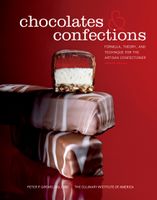🔥 Try our grilling cookbooks and save 25% on ckbk membership with code BBQ25 🔥
Technique Theory: Crystallizing Centers
By Peter Greweling and Culinary Institute of America
Published 2007
- Boil the Sugar and Water to 72° Brix. Brush the Sides of the Pot Well During Cooking. Higher sugar concentrations will result in more, but smaller crystals. The syrup contains no doctoring agent because the object is for it to crystallize. The density of the syrup must be above 67° Brix, since that is the saturation point for sucrose at room temperature, and the solution must be supersaturated in order to crystallize. If the syrup is boiled to a higher density, it will crystallize too rapidly, creating an excessively heavy crystal coating, one that coats all the surfaces in the container as well as the centers. Good sugar-cooking technique is imperative to prevent premature crystallization, and removing sugar crystals from the sides of the pot is the most crucial step in controlling the process.
- Cover the Syrup with a Wet Cloth, and Leave Undisturbed Until Cooled to 21°C/70°F. The syrup must cool to below the melting point of the center, which is often ganache. As it cools, it becomes supersaturated. It must not be agitated so as not to crystallize the syrup prematurely. The wet cloth over the syrup creates a high humidity microclimate over the syrup, helping to prevent the formation of crystals on the surface due to the evaporation of water.
- If Sugar Crystals Form on the Surface Of the Syrup While it is Cooling, Dissolve them by Floating a Thin Film of Cool Water on the Surface of the Syrup. In spite of the wet towel, the syrup frequently begins to crystallize on the surface. If left unchecked, these crystals can seed the syrup, setting off premature and uneven crystallization of the sugar. When water is sprinkled onto the heavy syrup, it forms a film on the surface, dissolving any existing crystals and preventing the formation of new ones.
- Place the Centers Between Screens in a Candying Pan, and Gently Pour the Cooled Syrup Over them Until they are Completely Immersed. Cover, and Leave Undisturbed at Room Temperature for Approximately 15 Hours. The screens will allow the syrup to contact all sides of centers so that they will crystallize all the way around, protecting the entire center from future moisture migration. In addition, the screens prevent the centers from either sinking to the bottom of the tray or floating to the top of the syrup. Approximately 15 hours is required for the sugar to crystallize to the desired thickness on the centers. It is important not to agitate the tray during this time so that the sugar crystallizes evenly.
- Remove the Centers from the Syrup, and Allow them to Dry on an Icing Screen at Room Temperature for 24 Hours. Leave the centers on one of the screens so that the excess syrup can drain off. Overnight drying ensures that the crystalline shell is strong and crisp.
The Syrup May be Reboiled and Reused. The syrup may be reused repeatedly as long as it is kept clean and is returned to 72° Brix before each use. After several uses, however, inversion will make the syrup unusable for this technique.
Basic Formula for Crystallizing Syrup:
3500 g/7.7 lb sugar
1500 g/3.3 lb water
Method:
Boil the sugar and water together following the sugar-cooking technique. Adjust the density of the finished syrup to 72° Brix using a refractometer.
Become a Premium Member to access this page
Unlimited, ad-free access to hundreds of the world’s best cookbooks
Over 160,000 recipes with thousands more added every month
Recommended by leading chefs and food writers
Powerful search filters to match your tastes
Create collections and add reviews or private notes to any recipe
Swipe to browse each cookbook from cover-to-cover
Manage your subscription via the My Membership page
Part of
Advertisement
Related Recipes
-
-
-
-
Related Reference
-
-
-
-
Advertisement




